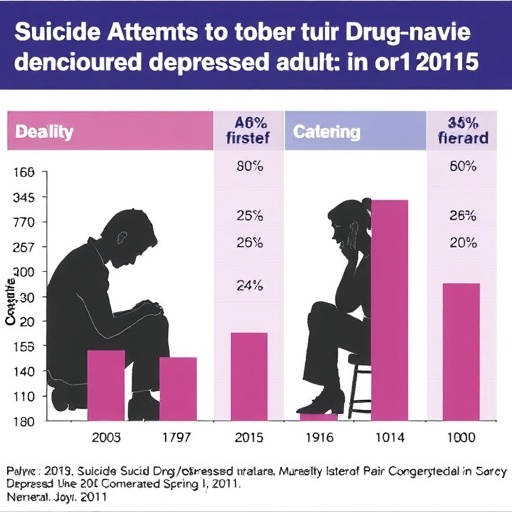In a groundbreaking study published in BMC Psychiatry, researchers have illuminated critical dimensions of suicide attempts among a vulnerable yet often overlooked population: working-age adults experiencing their first episode of major depressive disorder (MDD) who have never received drug treatment. By meticulously analyzing clinical, psychological, and biochemical markers in 1,701 Chinese patients aged between 18 and 59, the study reveals a complex interplay of factors that elevate the risk of suicide attempts in this group. This research not only fills a notable gap in psychiatric epidemiology but also opens new avenues for early detection and intervention strategies targeting suicide prevention.
The study’s findings are particularly significant given the alarming prevalence of suicide attempts detected—20.2% of the sample population reported at least one lifetime suicide attempt. This statistic underscores a stark reality: even among untreated first-episode MDD patients, suicidal behavior is a pressing concern that demands urgent clinical attention. Previous research has often focused on chronic or medicated depressive patients, but this investigation turns the spotlight on a cohort at the initial stages of illness, offering fresh insights into early risk factors that may otherwise remain undetected.
Key to this research was the incorporation of a diverse set of data points. Alongside comprehensive sociodemographic and clinical assessments, the investigators collected nuanced biochemical data, enabling a multifaceted analysis. Among the clinical instruments employed, the Hamilton Anxiety Scale (HAMA) and the Clinical Global Impression of Severity scale (CGI-s) emerged as powerful indicators, exhibiting a strong association with suicide attempt history. These scales measure anxiety symptoms and overall illness severity, highlighting the vital role psychological distress plays in suicidality beyond depressive symptoms alone.
Intriguingly, the study also identified physiological correlates that have traditionally received less attention in psychiatric risk assessments. Systolic blood pressure and thyroid peroxidase antibody levels were independently linked to suicide attempts. This discovery suggests a previously unrecognized overlap between cardiovascular markers, autoimmune thyroid dysfunction, and suicide risk in MDD patients, emphasizing the necessity of a holistic approach that integrates somatic health evaluations into psychiatric care.
Moreover, the researchers reported significant alterations in lipid metabolism among suicide attempters, characterized by a pro-atherogenic lipid profile. Dysregulated lipid levels, notably those that foster atherosclerosis, have been implicated in depression and suicide, potentially through mechanisms involving inflammation and neurochemical imbalances. These findings suggest that metabolic health abnormalities may serve as biological fingerprints of heightened suicide risk, paving the way for biomarker-informed screening protocols.
The high discriminative ability of the HAMA and CGI-s scales was further confirmed through receiver operating characteristic (ROC) curve analysis. This statistical method demonstrated that these psychological measures could reliably differentiate between patients with and without a history of suicide attempts. Such validation underscores the utility of these scales not simply as general clinical tools but as crucial components in targeted suicide risk evaluations during initial psychiatric assessments.
Collectively, the study advocates for an integrated clinical model that weaves together psychological metrics, cardiovascular indicators, and metabolic profiles in the assessment of suicide risk. This model challenges the traditional compartmentalized view of mental illness by advocating for cross-disciplinary collaboration, urging clinicians to consider physical health parameters that may subtly but critically influence mental well-being and suicidality.
The implications for clinical practice are profound. Early identification of at-risk individuals through combined psychological and biological screening could drastically enhance preventive efforts. Given the modifiable nature of some of these risk factors—such as hypertension management and lipid regulation—timely intervention could mitigate suicide risk substantially, especially in patients yet to initiate pharmacological treatment.
Importantly, the emphasis on working-age adults carries social and economic significance. This demographic forms the backbone of the workforce and family structures, and suicide or suicide attempts within this group can precipitate far-reaching consequences extending beyond individual suffering. The study calls for heightened awareness and resource allocation for suicide prevention programs tailored to this population segment.
By focusing on first-episode, drug-naïve patients, the research eliminates confounding influences of prior medication on biochemical and physiological parameters. This methodological rigor strengthens the reliability of the correlations uncovered, offering a clearer window into the natural pathology of MDD-associated suicidality before the complexities of pharmacotherapy intervene.
The study’s findings also stimulate further research questions. How do thyroid autoimmunity and cardiovascular factors mechanistically contribute to suicide risk? Could lipid-modifying treatments serve as adjunctive interventions in suicide prevention? These inquiries beckon multidisciplinary investigation spanning psychiatry, endocrinology, cardiology, and molecular biology.
In summary, this extensive study underscores that suicide attempts in first-episode, drug-naïve MDD patients are multifactorial phenomena where psychological distress intersects with physiological dysregulations. Integrating anxiety levels, illness severity, blood pressure, thyroid antibody presence, and lipid metabolism into routine evaluations holds promise for refining suicide risk prediction models and ultimately saving lives. As the global mental health community contends with rising suicide rates, such nuanced research equips clinicians and policymakers with evidence-based tools to address this urgent public health crisis effectively.
Subject of Research: Suicide attempts and their correlates in working-age, first-episode, drug-naïve major depressive disorder patients
Article Title: Prevalence and correlates of suicide attempts in working-age, first-episode, drug-naïve major depressive disorder patients
Article References:
Wang, L., Xiao, Q., Hu, C. et al. Prevalence and correlates of suicide attempts in working-age, first-episode, drug-naïve major depressive disorder patients. BMC Psychiatry 25, 776 (2025). https://doi.org/10.1186/s12888-025-07163-x
Image Credits: AI Generated




